
The state flag of Alaska displays eight gold stars, forming the Big Dipper and Polaris, on a dark blue field. The Big Dipper is an asterism in the constellation Ursa Major, which symbolizes a bear, indigenous to Alaska. As depicted on the flag, its stars can be used as a guide by the novice to locate Polaris and determine true north.

The North American Vexillological Association (NAVA) is a membership organization devoted to vexillology, the study of flags. It was founded in 1967 by American vexillologist Whitney Smith, and others. Its membership of 1,100+ comprises flag scholars, enthusiasts, designers, collectors, conservators, educators, merchants, manufacturers, historians, and hobbyists from most states and provinces of the United States and Canada, and more than 30 other countries.
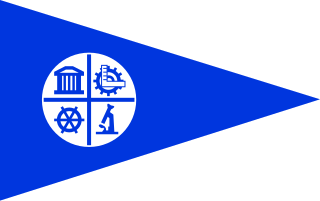
The flag of Minneapolis is the official municipal flag of Minneapolis, Minnesota.

The city flag of Los Angeles consists of a background of three notched stripes of green, gold and red. The flag was designed by Roy E. Silent and E.S. Jones in 1931 for the Los Angeles sesquicentennial from 1781.

The city flag of Portland, Oregon, consists of a green field on which is placed a white four-pointed star from which radiate blue stripes, each bordered by L-shaped yellow elements (esquarres). Narrow white fimbriations separate the blue and yellow elements from each other and from the green background. The official ordinance specifies a height of 3 feet and a length of 5 feet for the flag.

The flag of Denver is the official flag of the City and County of Denver in Colorado. It was designed by a North High School student, Margaret Overbeck, and adopted in 1926. A zigzag white stripe horizontally separates a red field below from a blue field above, in which is centered a yellow circle, together forming a stylized depiction of the Sun in a blue sky above snow-capped mountains. The color yellow symbolizes gold in the state's hills, and red the colored earth to which the word colorado refers. The circle's centered position symbolizes Denver's central location within the state. The white zigzag symbolizes Colorado's Native American heritage.
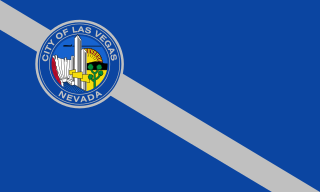
The flag of Las Vegas consists of blue field with a diagonal gray stripe running from the top of the hoist to the bottom of the fly. Las Vegas' city seal, adopted on March 16, 1966 and designed by Richard Thompson, is located in the canton breaking the stripe.

The flag of St. Louis, Missouri, consists of a solid red background and three thick, wavy lines colored blue and white extending from the top left corner, bottom left corner, and center right edge. At the intersection of these lines there is a yellow disk containing a blue fleur-de-lis.
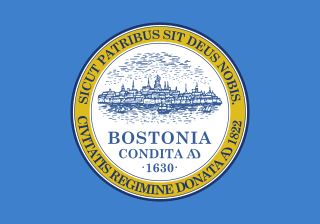
The flag of Boston consists of a sky blue field and the seal of the city of Boston, Massachusetts, United States, in the center. The flag is sometimes flown in a darker shade of blue, more of a turquoise. It was designed in 1913 and adopted by the Boston City Council on January 29, 1917.
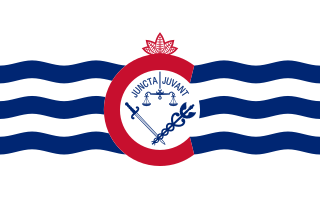
The flag of Cincinnati is the municipal banner of the city of Cincinnati, Ohio, in the United States. The design was selected in an 1896 contest. It was formally adopted on June 15, 1940.

The flag of Sioux Falls, South Dakota, consists of a zigzag pattern of thin white and blue lines, which divides an upper blue portion and a lower pinkish-red portion, and a yellow sun in the upper left corner. The zigzag represents the namesake falls of the Big Sioux River. The blue color and the sun allude to the flag of South Dakota. The pinkish-red portion represents the Sioux Quartzite nearby. The upward direction of the design represents the growth of Sioux Falls. The red, white and blue colors included in the flag are also a reference to the flag of the United States while maintaining city and state pride.

The flag of Charlottetown is the official municipal flag of Charlottetown, Prince Edward Island. It was designed by Robert D. Watt.

The flag of San Jose is the official municipal flag of San Jose, California. The current design, a triband of gold on top, white in the middle, and blue on the bottom with the city's official seal in the center, has been the official flag since 1984.

The flag of Austin is the official municipal flag of Austin, Texas. The flag simply consists of a white field with the seal of Austin without the surrounding circle of text. Below the seal of Austin is the text "CITY OF AUSTIN", written in blue and arched upwards.

The flag of Columbus is the official municipal flag of Columbus, Ohio. Its current design is a yellow, white, red vertical triband with the city seal on a blue field. Officially, the flag was adopted in 1929, although it is unknown if the flag was ever flown when it was first adopted.

The flag of El Paso is the official municipal flag of El Paso, Texas. The current design, an augmentation of El Paso's seal in the center of a dark blue field, has been in place since 1962.

The flag of Saint Paul is the official municipal flag of Saint Paul, Minnesota. Adopted via a 1932 competition, the current flag is a yellow-blue-yellow horizontal triband. A red shield depicting various aspects of St. Paul's industry and history is in the foreground and a red ribbon reading "SAINT PAUL" in yellow font below the shield.

The flag of South Bend, Indiana, was adopted by the city council during the mayorship of Pete Buttigieg on April 25, 2016. It is a field of white and yellow separated by a two blue curved lines with a white line between them and a red six-pointed star in the upper left corner.
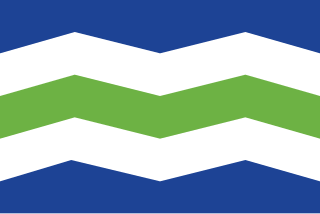
The flag of Burlington, Vermont was adopted by the Burlington city council on November 27, 2017 during the mayorship of Miro Weinberger. It is five horizontal, zig-zag stripes of blue, white, green, white, and blue.

The flag of Pocatello is the official flag of the city of Pocatello, Idaho, United States. The present flag was adopted on July 20, 2017, replacing the previous flag, used unofficially from 2001 to 2017. The former flag was considered by a 2004 survey of the North American Vexillological Association to be the worst of 150 selected US city flags. The current flag is commonly known as the Mountains Left, while the previous flag was known as the Proud to be Pocatello.





















